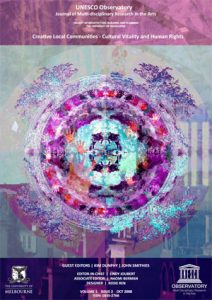e-Journal of Multi-disciplinary Research in the Arts, 2008
UNESCO Observatory, University of Melbourne
Vol 1, Issue 2: ‘Creative Local Communities: Cultural Vitality and Human Rights’
Guest editors: Kim Dunphy and John Smithies, Cultural Development Network

This issue features peer reviewed papers that examine the way policy and practice impact on the cultural vitality of local and wider communities. Authors from Australia, Poland, Spain, Canada, the United States and India present papers on themes:
- active planning for creative communities
- impact of the framework that includes cultural vitality as a necessary ingredient for the sustainability of local communities alongside economic, social and environmental concerns.
- the significance of freedom of expression and cultural rights, as an aspect of a broader human rights agenda.
- the relationship between creativity and cultural expression and health and wellbeing, and the ability of local communities to keep pace with change
Several articles examine the relationship between citizens’ rights of cultural expression and the role and responsibilities of government. Jordi Pascual from Spain elaborates UNESCO’s declaration of cultural rights in relation to the work of local government. Dr. Kevin Johnson and Kevin O’Connor provide detailed arguments for the value of cultural development in local government and give some advice for local government in Australia on developing relevant policies. Nancy Duxbury from Canada discusses measurement of cultural development, mostly in relationship to local government, through the emerging practice of cultural indicators and their relationship to community indicators. Kirsten Davies connects the environment, civic and cultural dimensions of local government work in her article about the model of Intergenerational Democracy. Jeff Stewart raises some challenges for local government when the values of graffiti artists, and the right to freedom of expression they claim, clash with those of residents and other community stakeholders.
The next series of articles explore the relationship between cultural and human rights and the relative values ascribed to these. Max Wyman from Canada expresses concerns about the low value usually ascribed to the cultural dimension of public policy, and proposes two strategic activities to address these; radical changes in education and increased advocacy by arts practitioners. Lisiunia Romanienko explores repression of sexuality in Poland by communism and the Catholic Church, and the contesting of this repression by aesthetic communities. Anmol Vellani adds a business development dimension through discussion about arts entrepreneurship in India. His article describes entrepreneurs who have been able to set up successful arts businesses without compromising the quality of outcome for artists or negatively impacting traditional cultures. Nil Sismanyazici-Navaie and Emine Etili-Serter also discuss social entrepreneurship in developing countries in their article examining the contribution of the arts to the achievement of the Millennium Development Goals.
The final series of articles are all from Australian authors. These examine the relationship between creativity and cultural expression and health and wellbeing, as well as the ability of local communities to keep pace with change. Isabel Jackson discusses the important social issue of reconciliation between indigenous and non-indigenous Australians, through an examination of the role of community festivals, while Raelene Marshall critiques the model of community cultural development that she believes is currently prevalent in Australia. And finally, moving from macro to micro communities, Maud Clark and Catherine Dinkelmann discuss the benefits of creative expression with two communities – rural young people experiencing disadvantage and disconnection from education, and residents of a nursing home. Editorial by Kim Dunphy.

